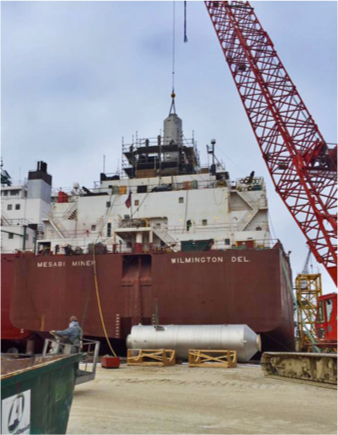Sustainability
Sustainable shipping is important to us. While we work hard to meet and exceed current regulations, our goal is to continuously improve our environmental profile because we not only work in and around the Great Lakes, it’s where many of us live and raise our families.
Our commitment is centered around three main focuses: reducing our air emissions, protecting our waterways and minimizing our environmental footprint.
Reducing Air Emissions
Converting our steamships to motor vessels and adding exhaust gas scrubbers (EGS) have been the cornerstones of our air emission reduction efforts. We’ve been leading the way with these efforts since 2006.
Now nearly half of our fleet is outfitted with freshwater scrubbers. The scrubber units, which are attached to the exhaust system of each of the ship’s two engines, effectively strip the majority of sulfur from its stack emissions. Exhaust gas from the engine is sent through a series of absorption sprays that “wash” and remove impurities, specifically sulfur and particulate matter. That washed exhaust gas then travels through a droplet separator before a signature clean plume of white steam is discharged into the atmosphere. The scrubber system relies on an injection of sodium hydroxide to neutralize and remove sulfur from the exhaust gas.
Watch for the signature EGS steam plumes on these Interlake vessels:
M/V Hon. James L. Oberstar, 806 feet, outfitted in April 2015
M/V James R. Barker, 1,004 feet, outfitted in June 2016
M/V Lee A. Tregurtha, 826 feet, outfitted in June 2016
M/V Mesabi Miner, 1,004 feet, outfitted in April 2017
The Queen of the Lakes, our 1,013-foot M/V Paul R. Tregurtha, sailed with scrubbers in 2018.
We are lowering our greenhouse gas emissions by harnessing the excess heat from our engines to heat the ship by making steam with the energy. This allows us not to have to run a boiler under normal operations.
Protecting Our Waterways
By virtue of never sailing outside of our freshwater Great Lakes-St. Lawrence Seaway system, our fleet cannot introduce an invasive species via our ballast water. Ballast water is needed to ensure the stability of the ship when it is not loaded with cargo. We follow best management practices to prevent invasive species from spreading. We continue to investigate new technologies that could aid us in this process in the future.
It is our mission to ensure oil – such as the fuel that is needed to power the engines– never comes in contact with the water. We have upgraded all of our propeller shaft bearings from oil-lubricated to water-lubricated bearings. This is just one example of eliminating water to oil interfaces on our equipment. We are switching to environmentally friendly oils, particularly in areas where a seal could be comprised. If an accidental spill happens, it is our promise to react quickly and responsibly.
Because our vessels are floating cities, each one has its own onboard sewage treatment system.
While we carry up to 70,000 tons of bulk cargo, a small amount of raw materials can end up on the deck. We follow U.S. Coast Guard regulation of where and how this material can be disposed.
Minimizing Our Environmental Footprint
We responsibly dispose of our refuse and have implemented a fleetwide boat recycling program.

Our Mesabi Miner receiving its exhaust gas scrubbers in February 2017 at Fincantieri Bay Shipbuilding
